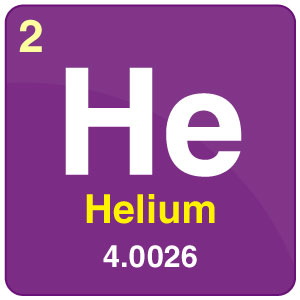
| Symbol | He |
| Atomic number | 2 |
| Atomic mass | 4.003 |
| Discovered by | Sir William Ramsay in London, Per Teodor Cleve and Nils Abraham Langlet. |

Table of Contents
What is Helium?
Helium, the lightest of the noble gases, had actually been detected and helium is the only element in the periodic table that was discovered by an astronomer.
-
-
-
- Helium is the element which you can find on the upper right side of the periodic table with atomic number 2. It comes first amongst the family of noble gases.
- It holds one atomic orbital and was named by Lockyer and Frankland. Its name is derived from the Greek word “Helios” meaning Sun. Scientists knew there was an enormous amount of helium in the Sun before it was discovered.
- Helium falls under inert gas since its outermost electron orbital is full of two electrons. Helium can also be found in lasers, compressed air tanks and coolant in nuclear reactors.
- It holds the lowest boiling and melting points amongst all other elements. Nuclear fusion of hydrogen in stars generates a significant amount of helium.
-
-
Isotopes
Helium has two known stable isotopes – 3He and 4He. The abundance of helium-3 and helium-4 corresponds to 0.0002% and 99.9998% respectively. This difference in abundances can be observed in the Earth’s atmosphere, where the ratio of 4He atoms to 3He atoms is approximately 1000000:1.
Physical Properties of Helium
| Helium (He) | Physical Properties |
| Melting Point | 0.95 K (or -272.2oC) |
| Boiling Point | 4.222 K (or -268.928oC) |
| Density | 0.1786 g/L at STP; 0.145 g.cm-3 at its melting point |
| Critical Temperature and Pressure | 5.195 K; 0.227 MPa |
| Triple Point | 2.177 K; 5.043 kPa |
| Appearance (at STP) | Colourless gas |
Chemical Properties of Helium
| Helium (He) | Chemical Properties |
| Electron Configuration | 1s2 |
| First Ionization Energy | 2372.3 kilojoules per mole |
| Second Ionization Energy | 5250.5 kilojoules per mole |
| Van der Waals Radius | 140 picometers |
| Enthalpy of Fusion | 0.0138 kilojoules/mole |
Uses of Helium
-
-
-
- The primary use of Helium goes in altitude research and meteorological balloons.
- It is utilized as an inert protective gas in autogenous welding.
- It is the only cooler capable of declining temperature lower than 15K (-434ºF).
- Helium is also used in the production of germanium crystals and silicon crystals.
- Since it has the ability to diffuse through solids much faster than air, helium is used industrially for pipeline leak detection.
- This element is also used in gas chromatography as a carrier gas.
- Owing to its low melting point, liquid helium has numerous applications in cryogenics, magnetic resonance imaging (MRI), and superconducting magnets.
-
-
Recommended Videos

Frequently Asked Questions – FAQs
What is helium used for?
Helium gas is used to inflate blimps, research balloons, and balloons for celebrations. It is used as an inert shield for arc welding, pressuring liquid-fueled rocket fuel tanks, and in supersonic wind tunnels.
What are the interesting facts about helium?
Helium is a chemical element with the He symbol and Helium is a colourless, tasteless, and odourless gas with an atomic number. Helium is the Universe’s second most common element (after hydrogen), accounting for around 24 per cent of its weight.
What type of element is helium?
Helium (He), chemical element, Group 18 inert gas (noble gases) of the periodic table. The second lightest element (the lightest is just hydrogen), helium is a colourless, odourless and tasteless gas that is liquid at −268.9 °C.
Why does helium have a low melting point?
So there is little interaction between the noble gas atoms, giving them a low boiling point. An important thing to note is that the inter molecular forces are rising with atomic size, and that’s why helium has a lower boil than neon, preceded by argon, etc.
Is helium used in medicine?
Helium gas can be used to treat conditions like asthma and emphysema for respiratory ailments. Liquid helium also has a medical function, as it is used in MRI scanners and NMR spectrometers as a cooling medium for magnets and process use.

thank you!!!! preparing for the test:)